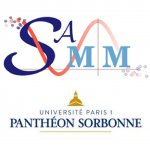Topics in Random Geometry & Stochastic Processes
This workshop is co-funded by GdR GeoSto and SAMM. It will take place on April 21st, in Room 1 - Faculté de Droit du Panthéon, 12 place du Panthéon, Paris.
10h Ellen SAADA (MAP5, CNRS - Univ. Paris 5 Descartes)
“Invariant measures of mass migration processes”
Abstract :
We introduce the “mass migration process” (MMP), a conservative particle system on ℕ^(ℤ^d). It consists in jumps of k particles (k≥1) between sites, with a jump rate depending only on the state of the system at the departure and arrival sites of the jump. It generalizes misanthropes processes, hence zero range and target processes. After the construction of MMP, our main focus is on its invariant measures. We derive necessary and sufficient conditions for the existence of translation invariant and invariant product probability measures. In the particular cases of asymmetric mass migration zero range and mass migration target dynamics, these conditions yield explicit solutions. If these processes are moreover attractive, we obtain a full characterization of all translation invariant, invariant probability measures. We also consider attractiveness properties (through couplings), condensation phenomena, and their links for MMP. We illustrate our results on many examples ; we prove the coexistence of condensation and attractiveness in one of them.
(In collaboration with L. Fajfrova and T. Gobron.)
11h Kirone MALLICK (IPhT, CEA)
“Large deviations of a tracer in the symmetric exclusion process”
Abstract :
The one-dimensional symmetric exclusion process, the simplest interacting particle process, is a lattice-gas made of particles that hop symmetrically on a discrete line respecting hard-core exclusion. The system is prepared on the infinite lattice with a step initial profile with average densities ρ+ and ρ− on the right and on the left of the origin. When ρ+=ρ−, the gas is at equilibrium and undergoes stationary fluctuations. When these densities are unequal, the gas is out of equilibrium and will remain so forever. A tracer, or a tagged particle, is initially located at the boundary between the two domains ; its position Xt is a random observable in time, that carries information on the non-equilibrium dynamics of the whole system. We derive an exact formula for the cumulant generating function and the large deviation function of Xt, in the long time limit, and deduce the full statistical properties of the tracer’s position. The equilibrium fluctuations of the tracer’s position, when the density is uniform, are obtained as an important special case.
(In collaboration with T. Imamura and T. Sasamoto.)
13h30 Coline Larmier (CEA)
Particle transport in stochastic tessellations : application to reactor physics
Abstract :
In nuclear reactor physics, the analysis of heterogeneous media with quenched disorder is key to many applications : assessing the probability of re-criticality after severe accidents leading to core melt-down, or evaluating the impact of steam-water dispersion on neutron slowing-down and diffusion. We assume that such disordered systems can be modelled by stochastic tessellations, which form a prototype model of random partition of space. We investigate the statistical properties of d-dimensional isotropic Poisson tessellations of finite size by resorting to Monte Carlo simulation. We characterize finite-size effects and determine the percolation threshold, the strength of the percolating cluster and the average cluster size. Moreover, we analyze the features of particle transport through an ensemble of such random tessellations, for simple benchmark configurations. In this framework, we determine the ensemble-averaged reflection and transmission probabilities for d-dimensional boxes with different initial conditions. Finally, we will present some annealed transport kernels of the Chord Length Sampling type that can mimic the effects of disorder (at the expense of neglecting spatial correlations).
14h30 Mario NICODEMI (Univ. di Napoli Federico II)
“Polymer models of chromosome architecture”
Abstract :
New technologies are being developed that provide quantitative data on the
3D organisation of chromosomes into the cell nucleus. I will discuss the
emerging picture of chromosome spatial structure based on experimental
data and physics modelling, along with its functional implications in
health and disease.
15h45 Dmitry Zaporozhets (Steklov Institute of Mathematics - St Petersburg)
Convex hulls of random walks : Expected number of faces and face probabilities
Abstract : (see link above)

